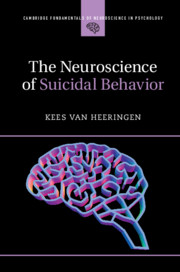Book contents
- Frontmatter
- Dedication
- Contents
- Figures
- Tables
- Preface
- Chapter One What Is Suicidal Behavior, and Can It Be Prevented?
- Chapter Two Stress, Vulnerability, and Suicide
- Chapter Three The Dark Side of the Brain
- Chapter Four Lethal Signals
- Chapter Five I Think, Therefore I Do Not Want to Be
- Chapter Six Images of the Suicidal Brain
- Chapter Seven “In my end is my beginning”
- Chapter Eight I Predict, Therefore I Cannot Be
- Chapter Nine Predicting the Unpredictable
- Chapter Ten The Treatment of Suicide Risk
- Glossary
- References
- Index
- Colour Plates
Chapter Five - I Think, Therefore I Do Not Want to Be
The Cognitive Neuroscience of Suicidal Behavior
Published online by Cambridge University Press: 22 May 2019
- Frontmatter
- Dedication
- Contents
- Figures
- Tables
- Preface
- Chapter One What Is Suicidal Behavior, and Can It Be Prevented?
- Chapter Two Stress, Vulnerability, and Suicide
- Chapter Three The Dark Side of the Brain
- Chapter Four Lethal Signals
- Chapter Five I Think, Therefore I Do Not Want to Be
- Chapter Six Images of the Suicidal Brain
- Chapter Seven “In my end is my beginning”
- Chapter Eight I Predict, Therefore I Cannot Be
- Chapter Nine Predicting the Unpredictable
- Chapter Ten The Treatment of Suicide Risk
- Glossary
- References
- Index
- Colour Plates
Summary
The core question in suicide prevention is: why does a person in a particular situation take their own life, while another person in the same situation would react in a different way? This chapter investigates to what extent and in which way neurocognitive studies may contribute to finding an answer to this question. The term 'neurocognitive' refers to the study of the relationship between the brain and behavior by utilizing specialized tests that have been designed to evaluate a wide variety of behavioral, cognitive and emotional domains. Thus, neurocognitive studies contribute to understanding how behavioral decisions following exposure to particular environmental stimuli relate to changes in brain functions. Such studies offer a great opportunity to measure and quantify cognitive functions, emotional states and behavioral repertoires through standardized questionnaires and testing. From such neurocognitive data, inferences are made regarding brain function and the localization of brain dysfunctions based on patterns of cognitive strengths and weaknesses. As conclusions from neuropsychological assessments are necessarily inferential, findings from neuropsychological investigations are commonly combined with those from neuroimaging (see next chapter) in order to fully understand the relationship between behavioral phenomena and changes in brain functions.
Keywords
Information
- Type
- Chapter
- Information
- The Neuroscience of Suicidal Behavior , pp. 85 - 101Publisher: Cambridge University PressPrint publication year: 2018
